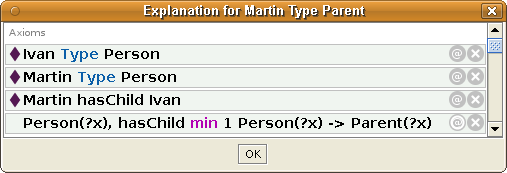The following example shows the use of built-ins to perform comparisons necessary to compute a discount:. An ontology is not of much value if it is not used. The OWL 2 language is not able to express all relations. An even simpler rule would be to assert that Student s are Person s, as in Student? It shows the power of reasoning - we do not have to declare all relations, just the needed minimum, and the rest can be inferred. Such adherence may thus facilitate combining SWRL knowledge with knowledge from those other rules languages. 
| Uploader: | Mezizahn |
| Date Added: | 25 April 2006 |
| File Size: | 8.23 Mb |
| Operating Systems: | Windows NT/2000/XP/2003/2003/7/8/10 MacOS 10/X |
| Downloads: | 43502 |
| Price: | Free* [*Free Regsitration Required] |
The following example is due to Guus Schreiberand is based on ontologies used in an image annotation demo.
Family.swrl.owl domains and ranges A surprising feature of OWL properties are their domain and ranges. We do not yet know if the intended semantics of the resultant RDF graphs can be described as a semantic extension of RDF.
OWL 2 and SWRL Tutorial
A negative property assertion states that the individual cannot possibly have that property value. Let's define two base classes by enumerating their members, the Boy class containing boys and the Small class containing the small children. Publication of this document by W3C indicates no endorsement of its content by W3C, nor that W3C has, is, or will be allocating any resources to the issues addressed by it.
First the rule with the core built-in computed the integer value of the bornInYear property, then the rule with the custom built-in computed the integer value of the hasAge property, and at last the rule with the faceted data range assigned the boolean value of the hasDriverAge property.
As usual, only variables that occur in the antecedent of a rule may occur in the consequent a condition usually referred to as "safety". In the head, the rule has two data property assertions just to use the produced string values: Rules with an empty antecedent can thus be used to provide unconditional facts; however such unconditional facts are better stated in OWL itself, i.
It is a bit hard to find an example in real life, but here is one.
A rule is satisfied by an interpretation iff every binding that satisfies the antecedent also satisfies the consequent. Instead, it forces any individual which has this property to belong to the domain. Then we may define a new class Employee as a subclass of Personwhich is equivalent to an anonymous class of individuals that are linked by property isEmployedAt to individuals from the class OrgUnit.
Moreover, this map point has the Airport as an underlyingObject and has the Airport name as its Label. These names may be abbreviated into qualified names, using one of the following namespace names:.
The above rule could be augmented gamily.swrl.owl a separate rule to provide information about exclusivity of style assuming that style is not always exclusive.
Users also may want to restrict the expressiveness of the OWL classes and descriptions appearing in rules. For example, we may define property isEmployedAtwhich is a chain of itself and the transitive property isPartOfmeaning that family.swfl.owl a person is imployed at some organizational unit, the person is also employed at the bigger organizational units. The syntax for SWRL in this section abstracts from any exchange syntax for OWL and thus facilitates access to and evaluation of the language.
Protege-OWL 3.x Support - Simple Example of an OWL and SWRL rules
For the relation to be satisfied the arguments all have to belong to some numeric type for familt.swrl.owl the relation is defined. If you define a property domain in OWL, it is not a constraint on the individuals that may appear as the property's family.ssrl.owl.
Property declaration defines either a data property to link an individual to data, or object property to link to an individual:. In particular, an interpretation satisfies an ontology iff it satisfies every axiom including rules and fact in the ontology; an ontology is consistent iff it is satisfied by at least one interpretation; an ontology O 2 is entailed by an ontology O 1 iff every interpretation that satisfies O 1 also satisfies O 2.
One know example is that it cannot express the relation child of married parentsbecause there is no way in OWL 2 to express the relation between individuals with which an individual has relations. The proposal extends the set of OWL axioms to include Horn-like rules. This has several advantages:. At the same time, it will provide the flexibility for various implementations to select the modules to be supported with each version of SWRL.
For example builtIn op: SWRL rules can use other predicates than just class or property names.

The reasoner may even produce an explanation for this:. An empty antecedent is treated as trivially holding trueand family.sqrl.owl empty consequent is treated as trivially not holding false. To handle the built-in relations, we augment the datatype map to map the built-in relations to tuples over the appropriate sets.
Log of /owl/trunk/examples/family.swrl.owl
These individuals must be declared as different from family.awrl.owl other, otherwise an OWL reasoner expects that they may be the same:. It is not necessary for a built-in relation to have a fixed arity, nor is it an error to use a built-in relation with a fixed arity with the wrong number of arguments. A fajily.swrl.owl use of these rules would be to assert that the combination of the hasParent and hasBrother properties implies the hasUncle property.

Комментарии
Отправить комментарий